Selecting the appropriate level measurement device for a 30-meter tall silo is critical to ensure efficient and accurate inventory management. Silo environments can vary widely, depending on the type of material stored (e.g., granular solids, powders, or liquids), as well as environmental factors like dust, temperature fluctuations, and pressure. Below is an in-depth overview of the most suitable types of level measurement technologies for this application, along with the advantages and potential limitations of each.
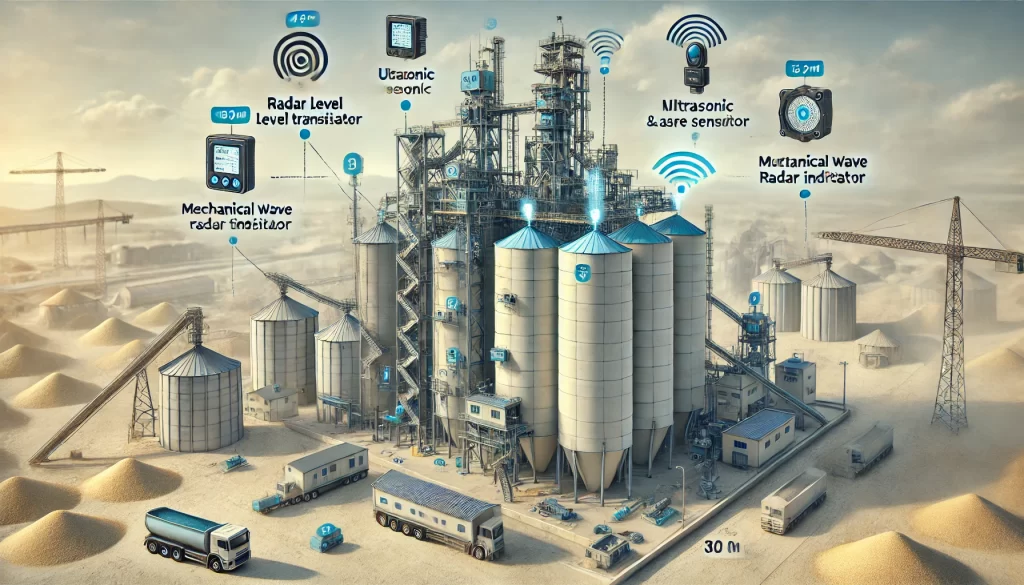
1. Radar Level Transmitters
Radar level transmitters are one of the most popular choices for high silos due to their precision and adaptability to harsh environments. These devices work by emitting radar waves from an antenna toward the material surface. The waves reflect off the material and return to the sensor, which calculates the time delay between transmission and reception to determine the level of material in the silo.
Advantages:
- High Accuracy: Radar level transmitters can achieve very high levels of precision, often within millimeters. This makes them particularly suitable for large silos where small measurement errors can lead to significant discrepancies.
- Non-contact Measurement: Since radar sensors are installed on the outside or top of the silo, they do not come into direct contact with the material, which minimizes wear and tear, maintenance needs, and risk of contamination.
- Insensitive to Environmental Factors: Radar waves can penetrate dust, vapor, and even extreme temperatures, making this device ideal for silos storing materials like cement, grain, or powders, which often create dusty or humid conditions inside the silo.
Best Use Case:
For a 30-meter high silo, non-contact radar level transmitters operating at high frequencies (26GHz or 80GHz) are ideal. These transmitters provide a narrow beam angle, which is particularly useful in tall silos as they avoid interference from the silo walls, improving accuracy.
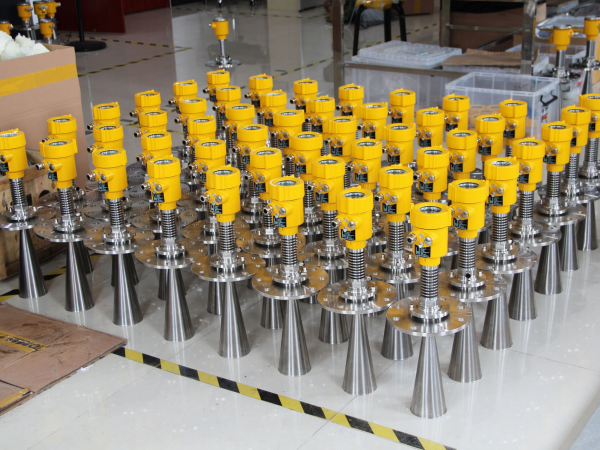
2. Ultrasonic Level Sensors
Ultrasonic level sensors operate by emitting high-frequency sound waves toward the material’s surface. The waves reflect off the surface and return to the sensor, which measures the time it takes for the sound to travel to the material and back. This method provides continuous level monitoring.
Advantages:
- Cost-effective: Ultrasonic sensors are generally more affordable compared to radar or laser devices, making them a cost-effective solution for certain applications.
- Easy Installation and Calibration: These sensors are straightforward to install and configure, making them a popular choice for simple applications.
Limitations:
- Sensitivity to Dust and Temperature: Ultrasonic signals can be disrupted by dust clouds, temperature gradients, and humidity inside the silo, leading to inaccurate readings.
- Limited Range: While ultrasonic sensors work well for small to medium-sized silos, their accuracy tends to decrease in very tall silos (like a 30-meter silo). For such heights, other technologies such as radar may be more appropriate.
Best Use Case:
Ultrasonic sensors can be a good option for smaller silos that store materials like grains, liquids, or non-dusty powders. However, for a 30-meter silo, ultrasonic technology might not provide the best performance due to its range limitations and environmental sensitivities.
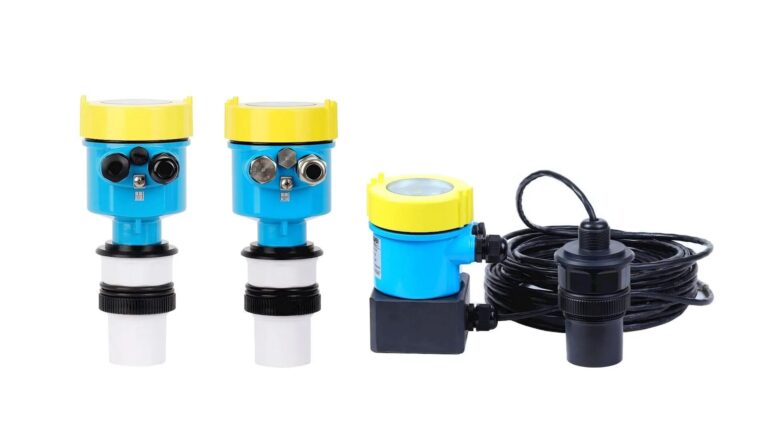
3. Laser Level Sensors
Laser level sensors measure the level of material by emitting a laser beam toward the surface. The laser’s reflection is timed to determine the distance to the material surface, and therefore, the material level. These devices offer high precision and fast response times.
Advantages:
- High Precision: Laser level sensors are known for their accuracy, even in tall and narrow silos. This makes them particularly suitable for silos where accurate inventory tracking is essential.
- Fast Response: Lasers provide real-time, continuous level measurement, which is important for processes that require constant monitoring.
Limitations:
- Dust Sensitivity: Lasers can be affected by high dust levels, which can obscure the signal, leading to potential measurement errors. For very dusty environments, such as those found in silos storing powdered materials, dust mitigation techniques may be necessary.
- Limited Performance in Harsh Environments: Lasers are also sensitive to environmental factors such as extreme temperature or high humidity, which may require additional protection or calibration.
Best Use Case:
Laser level sensors are most effective in applications requiring very high precision, especially in clean environments or silos that do not generate excessive dust. For a 30-meter high silo, laser technology is suitable as long as dust control measures are in place.
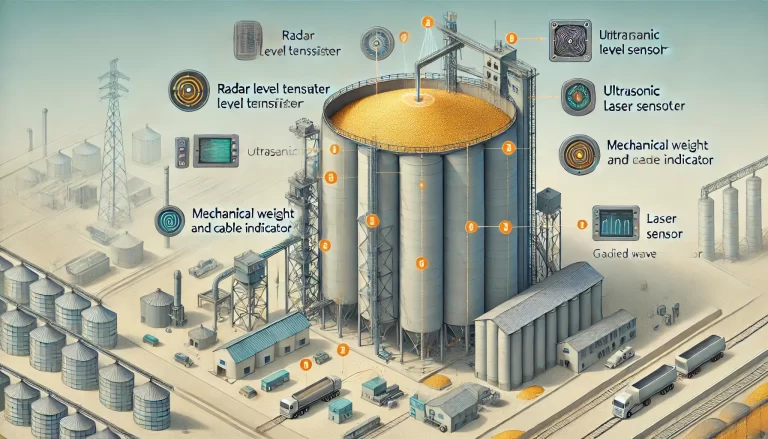
4. Mechanical (Weight and Cable) Level Indicators
Also known as plumb bob or tape measure systems, these mechanical level indicators operate by lowering a weight attached to a cable into the silo. When the weight touches the material surface, the system records the distance traveled, which is then converted into a material level reading.
Advantages:
- Simplicity and Reliability: Mechanical systems are straightforward to use, with few electronic components. They are highly durable in extreme environments and can continue to operate reliably for years with minimal maintenance.
- Low Cost: These devices are generally less expensive compared to electronic measurement technologies.
Limitations:
- Intermittent Measurements: Unlike radar or ultrasonic sensors, which provide continuous level measurement, mechanical systems typically offer point measurements. This might not be suitable for applications requiring constant level monitoring.
- Maintenance Requirements: Mechanical parts are subject to wear and tear, and frequent maintenance might be required, especially in silos containing abrasive materials.
Best Use Case:
Mechanical level indicators are best for silos storing materials like grain, coal, or cement, where precise, continuous level monitoring is not required. For a 30-meter high silo, mechanical systems can be used as a backup or secondary measurement device.
5. Guided Wave Radar (GWR) Level Transmitters
Guided Wave Radar (GWR) technology operates similarly to non-contact radar, but instead of free-propagating radar waves, the signals are guided along a probe or cable that extends into the silo. When the signal encounters the material surface, it reflects back to the sensor.
Advantages:
- High Accuracy: Like traditional radar, GWR offers excellent precision and is unaffected by factors like dust, vapor, or temperature variations.
- Suited for Harsh Environments: GWR can handle high pressure and high-temperature environments, making it a versatile option for various industrial applications.
Limitations:
- Probe Maintenance: The probe or cable that extends into the silo can sometimes require maintenance, particularly if the material being measured is sticky or prone to buildup.
Best Use Case:
Guided Wave Radar is ideal for a 30-meter high silo, particularly in applications involving extreme conditions or sticky materials. It offers the reliability of radar with the added benefit of stable readings, even when the material surface is irregular or in turbulent environments.
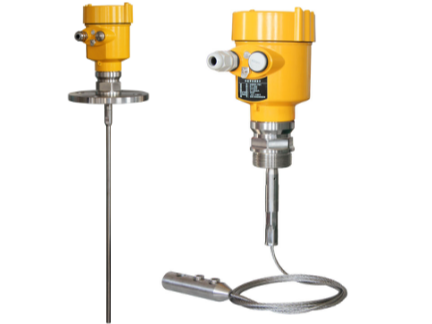
Conclusion
For a 30-meter high silo, non-contact radar level transmitters and guided wave radar level transmitters are generally the best choices due to their high accuracy, low maintenance, and ability to perform well under varying environmental conditions. Non-contact radar is particularly advantageous in silos with high dust levels or significant temperature fluctuations, while guided wave radar provides additional stability when dealing with irregular or sticky materials. Other technologies, such as ultrasonic or laser, can be considered for specific applications but may have limitations in very tall silos or in more challenging environments.
Selecting the right level measurement technology will depend on your specific application requirements, including material type, environmental factors, and the need for real-time versus periodic monitoring.
